Satoru Iwata opened the pre-E3 Nintendo Direct show with a declaration of Nintendo's intent to continue being unique — and a half hour long web show dedicated to its new console days before the start of E3 certainly fits into that category. Iwata promised that Tuesday's conference would focus "almost entirely on Wii U games", so software was left aside so that he could instead spill various beans about Wii U as a system. It's been a long time coming after a year of secrecy — so what did we learn?
Iwata pointed towards the trend of families and friends sitting together but simultaneously being alone, using their own separate multimedia devices, as a concept in the development of Wii U. The system is intended to unite rather than divide, whether that's in the same room or on the other side of the world.
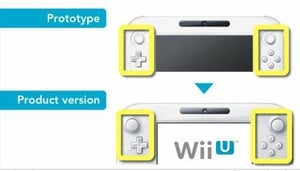
The Wii U controller is now officially known as the Wii U GamePad, named for its NES ancestor. It differs from the model seen at E3 2011 in several ways. It now hosts two clickable analogue sticks rather than 3DS-style sliders, the stylus holder has been switched over to the top right of the controller's back, the D-pad and face buttons have been moved so that they're not directly beneath the analogue sticks and the back has been redesigned for comfort.
There's also a square on the front-left of the pad for Near-Field Communication activities; place a card or figure on it and data can be read or written through the wireless technology. As an added bonus, Wii U GamePad can be used as an infra-red remote control for your television without the need for the system to be switched on. Its touch and motion functionalities were emphasised, though no changes were mentioned on those fronts.
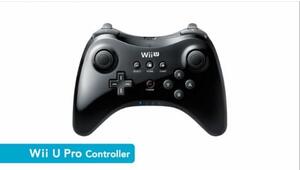
Wii U is compatible with existing Wii control options, such as the Wii Remote, Nunchuk and Balance Board. For those most interested in multi-platform titles, where the Wii U GamePad's screen might not be quite as crucial, a Wii U Pro Controller will be available. It's essentially a traditional game controller much like that of Xbox 360's, featuring two analogue sticks, four shoulder buttons and four face buttons.
A crazy video showed a man unable to defeat a zombie and begging for help on a game-specific messageboard via Wii U GamePad. As well as showing off a black version of Wii U, this video began to show off the level of interaction that makes up Wii U's online system. Each game has its own bulletin board where you can share messages with others that are playing; a social network thread for each title. If typed messages aren't enough, you can also use video chat to communicate with others using the Wii U GamePad as your camera.
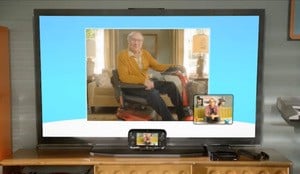
Iwata also treated us to a first look at Wii U's Home menu — essentially an expanded, always online Mii Plaza known as Miiverse. The development team have been referring to it as Mii Wara Wara, a Japanese term that refers to the "general noise and commotion" of a crowd. Dozens of Miis gather around various games icons, sharing status updates and live conversation through speech bubbles. Any Miis stored on your Wii U, your friends and anybody sharing a common language playing the same games as you will turn up. Wii U GamePad is used to select actions and access games, while the television screen is tiled with the most popular games currently being played, whether you own them or not. These views are interchangeable between controller and TV.
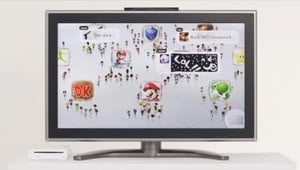
Miiverse can be activated at any time mid-game to communicate with others. You can send text messages, scribble handwritten notes and doodles, even take and send screenshots or user-created content over the network. Every Wii U game is compatible, the Miiverse always accessible on the Wii U GamePad's screen with a tap of the Home button. Miiverse can also be incorporated without ever halting the game. A 2D Mario title, known as New Super Mario Bros. Mii (working title) at E3 2011, has players chatting all over the map screen and lets you annotate sections of the game with comments; to lament a death, perhaps. These notes can be shared in other players' games — but don't worry, as Nintendo will be trying to restrict spoilers. Even in a single player game, without traditional online interaction, Miiverse will be present and available.
These social activities are planned to be shared away from Wii U too. Miiverse will only be on Wii U at launch, but it's been designed to be used with Wii U, Nintendo 3DS and any future Nintendo consoles. It'll soon be expanded so that it's accessible in some form via the world wide web and mobile devices as well.
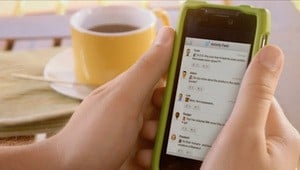
Iwata finished up by describing the relationship concept of Wii U. It aims to change the relationship between family and games, games and television, television and the internet. Wii U GamePad can be used as an internet browser in the palm of your hand, but content can also be shared with the TV. Virtual curtains can be draped over the television screen before revealing content to your rapt audience, lending an air of showmanship and entertainment to the simple act of internet browsing.
Nintendo believes that Wii U has the potential to solve the problem of alone together. It aims to share more smiles, more laughs, more empathy, wherever you are playing. Wii U will connect to the Miiverse to bring friends, family and others together — even with nobody else in the same room, you won't be alone.
Don't forget to tune in to Nintendo's E3 press conference on Tuesday, where Nintendo will finally show off Wii U games. 3DS won't be left behind though — there'll also be plenty of news about the handheld platform too.





Comments 44
I like how I can check up on things happening with my friends on my phone. And glad that it isn't dedicated to just smartphones- but ANY phone that has a web browser.
So much to look forward to.
E3 is going to be so awesome this year.
Thank you for the summary
Cool to hear they're finally stepping up the plate big time with online connectivity. Whether it'll actually deliver this time only time will tell.
Are you sure there will be 3DS news? Iwata's comments have me thinking otherwise, and I think it would be a huge mistake to leave the 3DS out of E3.
@Radixxs I'm not sure when exactly the 3DS news will be coming, but Iwata does mention that there will be some at the end of the video. Whether that means 3DS will feature on the E3 stage or Wii U gets it all to itself, or whether 3DS is the focus of the 'Software Showcase' later on in E3, I don't know.
When I saw the GamePad and console in black I almost passed out. Of course, I'm not taking black for granted until it is officially announced for NA. But it looks promising.
@Mason Alright, that's comforting. Wii U news is great, but I want to know what I get to play for my already-purchased 3DS.
And the caption for the first pic is kinda creepy.
@Mason Well, Nintendo did say the main presentation will focus on Wii U software, so I think it is somewhat likely the software showcase will show off 3DS games as well - they can't simply ignore it! I hope at least we'll get a montage of trailers for games we know about and a few new announcements, with release dates and other game reveals coming in future conferences.
And that was just an appetizer! Make ready your bodies for the main course.
Don't give up hope on 3DS:

Y'know what they should do? Localise Pandora's Tower... for Wii u.
This sounds really great! I like the direction this is going. The Pro controller looks great for my style of Mario Kart and Smash Bros!
Anybody catch the simpsons episode tonight? It was awesome, they went to "E4" and played games like World of Krustkraft and Guts of War and Grand Theft Scratchy. Homer, lisa, and bart sneak into the FUNTENDO conference to see the new system debut!!!!!!!!!! How awesome is that?!?!?
man wii u just keeps getting better and better!!!
I hope they do something for the 3DS at e3. They have to be working on games and we still need info on the games announced last year.
YEEEEEEEEEEEEEEEEEEEEEEEEEEEEEEEEEEEEEEEEEEEEEEEEEEEEEEEEEEEEEEEEEEEEEEEEEEEEEEEEEEEEEEEEEEEEEEEEEEEEEEEEEEEEEEEEEEEEEEEEEEEEEEEEEEEEEEEEEEEEEEEEEEEEEEEEEEEEEEEEEEEEEEEEEEEEEEEEEEEEEEEEEEEEEEEEEEEEEEEEEEEEEEEEEEEEEEEEEEEEEEEEEEEEEEEEAAAAAAAAAAAAAAAAAAAAAAAAAAAAAAHHHHHH!!!!
Man Wii U just kicked it into overdrive with AWESOME! ! I love the entire thinking they bring to their new console & how it's not just the touch screen that makes this console unique but it's amazing connectivity & the new ways it brings fun into our lives I'm pretty much sold on this console based off the concepts shown in the video alone without seeing any full games on it either It'll be my 1st console bought at launch, or at least in the launch period of the 1st couple of months.
It's official. Nintendo wins E3, and it hasn't even started yet! Winner, winner, chicken dinner!!!
I wonder why it will take them so long to build the browser and mobile apps. Having the entire concept live and on display could help push initial demand into overdrive at a time when the general vibe seems ambivalent at best.
I understand now how Ubisoft will be able to show off their Wii U games even before the Nintendo press conference. That fact kind of baffled me when I first heard it because Nintendo wouldn't just allow them to be the first to show off the new tech. That said, I'm now even more interested in the Ubisoft presentation tomorrow since they won't have any need to censor any of the system's functionality for Nintendo's sake.
@TimboBaggins Wow. I may have to check that Simpsons episode out.
The Wii-U is to the Wii what the SNES is to the NES. It's the the Super Wii!
Agreed, its effectively the "super Wii" (like the SNES). VERY promising stuff. Need to use it in actual practice to fully appreciate - but very good this.
@WaveBoy so don't use those functions. There, problem solved
Controller choices leave me a bit doubtful. The Wii U GamePad was briefly said not to be be best suited for longer gaming sessions and the BAYX and D-Pad placement on the Wii U Pro Controller doesn't look comfy to me.
Most of all i'd like to see the communities idea of MK7 expanded and made a system feature on the Wii U though. Miiverse could be really fun with a whole group of people you know.
If the gamepad really is getting uncomfortable after a while only then I will buy this controller pro
Is there any news on whether Wii U games will also support the current Classic Controller (Pro)?
It'd suck if I had to buy 3 more Controllers instead of using the ones I currently have, when they're almost identical in function.
Good to know that all that social-networking-style noise is optional. It's a neat idea, but also looks kind of annoying.
Can't wait to call pedograndpa123 and ask how for help.
@WaveBoy Your comment is making me facepalm to no end.
I'm totally loving the idea of the MiiVerse. The WiiU game pad looks brilliant, the controller pro looks nice too even though it's basically a 360 controller with different placement of buttons and sticks. Also Non Specific Action Figure is total win on so many levels. I'm hoping he gets his own game and figure release with NFC tech behind it like Skylanders but I know that's a long shot.
Another longshot would be if DQX is shown off for WiiU complete. I would like a showing of it though with a worldwide release date. I was always going to buy a Wii U anyway but now, im really really really excited for it and it's features. And e3 has hardly started yet. Nintendo are going to "win" the show again. Im wishing Nintendo all the luck in the world with Wii U. Everything seems to falling into place quite nicely. If only we were getting a price and release date. I hope it's released sometime in August or September. Again another long shot but I can dream.
I hope the browser isn't slow-ass useless as on every other nintendo system. Actually I bet it is, otherwise it would consume resources...
I can understand why Mr. Iwata said there wouldn't be much in the way of 3DS news at the conference other than upcoming games. There really doesn't need to be, which means no re-design unveiled or anything like that. Which is fine, all I care about with my favorite little handheld are the upcoming games like Paper Mario, Animal Crossing, etc...
After going back over all of the Wii U stuff he covered in his 30 minute presentation, I know I have a ton of questions about the new system. I'm sure all of you on this board do too. I'll be looking forward to their presentation as this week unfolds.
Good plan by Nintendo. Get the boring stuff out of the way first, in a short video.
I'm definitely getting this. It's just a matter of when, if it's less than $350, then I'll get it with Christmas gift cards. Otherwise it will have to wait until next year.
Here's my point-by-point round-up of what jumped out at me:
1. Twitter and Skype like services presented within a minute of each other, makes me think they finally get it and are willing to embrace the enemy that is Apple
2. black - much better than white, it just is
3. Wii U Gamepad stand for SkypeU - I don't see any way in hell that Skype session can work from that far away, that's like a 1,000 zoom lens, and can we please just start calling it the UPad now, nobody is going to be type "Wii U Gamepad" whenever they want to comment about it
4. Pause DURING gameplay for social interaction, muy bueno
5. Wii wara wara - it's so stupid it works, and it explains where Wario came from
6. I'm really going to enjoy Reggie tomorrow, Iwata was killing me. Not his fault, but that 30 minute video could have been an awesome 15 minutes. Maybe Nintendo needs a VP of everything spokesperson.
7. If they are giving all of this away BEFORE E3 they must have a lot of confidence in their E3 presentation
That's a lot to get out of a 15 minute hardware and online oriented video (with a 15 minute feng shui introduction). Now about that price and release date info...
Timbobaggins sweet simpsons episode
I'm not quite content with the MiWaraWara. Iwata said the crowd would be of people from your country or speaking your language but I live in a foreign country and my family and I speak more than one language. Please don't make me choose, Nintendo!
Why no mention of cross game chat? It looks like the skype type calling is outside of game... being able to voice chat with a group of friends while playing an online multiplayer game is a key feature and if this is not included it will set the Wii U behind the competition. Did you see a plug-in for a headset on the controllers?
All I can say is, I know what I want for Christmas! Geez 24 hours never seemed so long as it does now... Can't wait to see Olimar once again!
Nintendo needs to push way further, Sony already added Skype to its Vita (which has and will have an audience of a different order of magnitude compared to any miiverse) and it is already able to work as remote control and remote display for PS3 games. But all of this is provided by raw software, MS could also do the same with any system update and stream video to an i-Pad, or windows Phone for example or use it as remote control, you just need a software driver. The miiverse concept is a big step forward compared to the Wii, but not enough to give N any substantial advantage over the rest.
@Shruikan I know, right? One of the funniest Simpsons episode I've seen in a long time, and its a new one! This restored my faith in the show
@SMW The simpsons episode is called "The Food Wife" I think it actually debuted in november, but the timing of the reairing was perfect for this weekend
I won't buy the Wii U anytime soon u.u It's a great piece of hardware and software and amazingware, but for many reasons I should wait... but I'm excited to discover this new console =) SO I'm excited about all the 3DS announcements we'll hear today =) I'm quite happy right now ^^
Anyway, thanks for the briefing; there are plenty of us who are at the office working at this very moment! So we can't see everything live. Thanks for your posts and tweets =D =)
Show Comments
Leave A Comment
Hold on there, you need to login to post a comment...